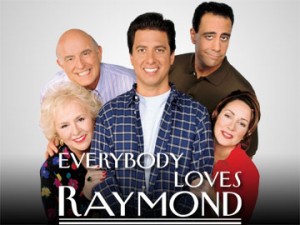Follow our Pinterest Boards
I learned that Sit-Coms just spit it out. On one episode of Everybody Loves Raymond, Raymond’s brother Robert comes over to take the kids to the zoo. Raymond realizes that the kids might even like Uncle Robert more than him. Robert actually spits it out: You’re not a good father.
Of course, in a sit-com, all you’ve got is the dialogue. Like movies, you can’t get in the characters’ heads, you only have dialogue and actions to make a point. Robert clearly expresses his opinion of Raymond’s parenting skills–in the dialogue.
Raymond, of course, retaliates and tells Robert that he needs to get a life.
Fast forward to the end: Raymond has had a successful (sorta) day at the zoo with the kids and comes home to find Robert in the hot tub with two hot chicks.
Robert: Looks like you are a good father.
Raymond: Looks like you got a life. I’d get in that hot tub with you, but I didn’t come prepared.
Robert: That’s OK, you can use my swim trunks, they are over there. (Beat. That means wait for the audience to get the joke and laugh and appreciate it.) Just kidding.

I learned that the emotional content in a sit-com is laid bare. Characters actually say what the theme of the story is. Here, it’s a two-fold question: Is Raymond a good father? Does Robert have a life outside his duties as uncle? The important moments along the character’s emotional arc are so obvious. And isn’t that nice for the writer? We don’t have to imply, infer, implicate. Just spit it out.
As a novelist, I know that I have more tools than a scriptwriter, so I can put some of the characters’ tensions, fears, and pains into interior dialogue, narrative sections and can use sensory details to fully flesh out a scene and create the right mood. But I’ve added a new tool: Just spit it out.
Timing is crucial. Above, I had the aside about the BEAT, the pause for the audience to get the joke. Sit-coms work because the actors and actresses have superb timing. One book on acting in sit-coms emphasizes the importance of the actor/actress following EXACTLY the script, especially in terms of punctuation. Where should the character hesitate, pause, speed up, scream, whisper–in short, the scriptwriter is allowed to direct the pacing and delivery of the dialogue.
I’ve taken a new look at my punctuation this week, with an eye to pacing the delivery of dialogue. Am I using silences, pauses, hesitations, stuttering, speeding up, etc. to create an extra layer of meaning, to make jokes work, or to characterize?

How Does Your Character Change?
You know your character must change somehow over the course of your novel. But how? And more than that, how do you sync the changes with the external plot? The middle of a novel can suffer from the dreaded “sagging middle” and it’s mainly because you don’t have a firm handle on the character’s inner arc and how it meshes with external events.
I’ve found three approaches to the inner arc, each trying to laying out how the character changes. While these overlap a lot, there are differences in how the emotional changes are approached.
Hero’s Journey: Quest for Inner Change
 In the Hero’s Journey, laid out so well in Christopher Vogler’s book, The Writer’s Journey, a character receives a Call to Adventure that takes him/her out of the normal and ordinary world into a world where they must quest for something. One of the key moments in this paradigm is the Inmost Cave where the character faces his deepest fears.
In the Hero’s Journey, laid out so well in Christopher Vogler’s book, The Writer’s Journey, a character receives a Call to Adventure that takes him/her out of the normal and ordinary world into a world where they must quest for something. One of the key moments in this paradigm is the Inmost Cave where the character faces his deepest fears.
Melanie as an Example
So, we’ve got Melanie who wants more than anything else to get her mother’s approval, but can’t because her mom’s a chef and Melanie can’t cook worth a flip.
In the Hero’s Journey, Melanie might get a Call to Adventure: a challenge to create the world’s largest hot fudge sundae. Her darkest moment will come when she realizes Mom think’s she’s real goof-up and she’s not up to the task. Of course, she wants to give up, but somehow manages to rally (perhaps, recruiting friends to help, learning to make a sundae, etc.) and create something that makes Mom proud.
Iron Sharpens Iron – Friendships

As iron sharpens iron, so one man sharpens another. Proverbs 27:17
In this paradigm, two characters cross paths in Act 1 and usually hate each other, but Act 2 throws them into a situation where they must act together. Here, the characters’ strengths and weaknesses work to create change. It’s an up and down battle of learning to trust each other and ultimately find some sort of love, whether it’s platonic, romantic or maternal. Key moments are the midpoint when they totally lose faith in one another and a re-commitment to each other as they move from Act 2 to Act 3. Act 1 and 3 focus on the external story, while Act 2 follows how the friendship affects the characters.
For more on this paradigm, read, Emotional Structure: Creating the Story Beneath the Plot by Peter Dunne.
Back to Melanie:
Melanie agrees to participate in the Biggest Sundae Ever contest, but as the contest starts she’s assigned a dunce to work with, Phillip RunnyNose. They clash immediately and have different ideas on how to create the required masterpiece: Melanie wants total creative control, while Phillip wants to just take pictures of the masterpiece. During their practice run–about the middle of act 2–Phillip leaves the ice cream out to soften up, but it melts, ruining the prac
Use Character Traits to Make Your Character Sympathetic
Yesterday, we looked at 9 character traits that can be used to develop sympathy for your character. Today, we’ll look at using those traits in your story. It’s not enough just to tell yourself, or write on a checklist, that your character has these traits and is, therefore, instantly sympathetic. You must USE these traits. How?

Literary agent Donald Maass is a master of telling us how to use traits to create break out novels. He pushes you to go farther and deeper at ever turn.
Using the Character Traits
- Flaws. For character flaws – a necessary part of a sympathetic character, since perfect characters are not sympathetic – try making the character aware of his/her problem. When the character berates him/herself for being so grouchy in the morning, we have sympathy. When I announced to my 5:45 a.m. spinning class that I was a Grouch, that I had gotten up on the wrong side of bed, they all laughed and were extra kind to me that day. (The instructor still made me work hard, but at least I didn’t have to talk to anyone and pretend to be nice.)
- Hero or Heroine. Take any of the character traits we talked about before and push or shove it until it becomes heroic. Be careful not to become comic or melodramatic; but push the limits of what you can do with one trait.
- Multiply. Remember we said that victims get a certain amount of sympathy and pity. What if your character is a victim of multiple things? Pile it on and we’ll sympathize even more. Not only is your character in a wheelchair from a car wreck, but the bank is about to foreclose on her business; and she’s about to discover the cure for the common cold. That piles it on AND gives it a wider, public scope. Be careful here or we’ll get that contempt for this poor victim who can’t rise above her circumstances. But multiplying conflict is one way to increase sympathy for a character.
- Inner conflict. Give your character conflicting Dreeds and Plopes (dreams, needs, hopes, plans) and you increase sympathy. How can your character possibly choose between justice and the ineptness of the justice system?
- Paradox: While characters should be consistent, if you can add a believable paradox, you quicken our interest. The key is making it believable. What is it that your character would never say, do or think? Have them say, do or think it! But make sure you make the motivations and emotions clear.
- -Er or -Est a Trait. Push the trait to an extreme: Bigger, smallest, most vulgar, funnier, more clever, clumsiest. Make sure the reader notices your character!
- Raise the Stakes. Take their Dreeds and Plopes and make them matter more, put more at stake. The outcome of the hero/ine’s sacrifice will affect their family, their profession, the world. Why do you think evil men are always trying to “take over the world”? So they have the widest possible stakes. Take a cue from that cliche, though: make the increased stakes believable.
- Inner Change i
While my WIP novel is out with readers, I thought I’d look at my process for this novel and how it differed from others.
Writing Process for Novels Vary Widely
Writing process varies. First, my process was different for this novel. I find this to be always true, that what worked for one novel, won’t work for the next. In general the steps are the same, but I spend more time on one step, or do them in different orders.
Compensate for weakness. I did some evaluation of my novel ideas, works-in-progress novels, failed novels, and successful novels. I am a very private person; I’ll post information all day long, but rarely will I post anything personal. Frankly, it’s none of your business. Unfortunately, I carry that attitude over to my novels and the most common response is that “I failed to be engaged by the characters.” Of course. It’s none of your business!
So, I went looking for ways to improve the emotional life of my characters and found several helpful books and ideas on a character’s emotional arc.
Find software to support needed improvement. One suggestion on emotional arc was to use index cards to plot, writing ideas for one scene per card. Then, turn the card OVER and on the back, write the character’s emotional state during the scene. In other words, plan the character’s emotional arc.
I’ve used many different ways of plotting and I’ll tell you, never has index cards worked for me. I’ve used spreadsheet plotting and I like it very much. So, I simply added a column for the emotional state of the characters. It did work, but somehow, it didn’t seem to get me moving through the story well.
Enter YWriter, a free program that helps you plan and organize a novel. This time, since I wanted to do a better job of planning, especially the characters’ inner lives, YWriter was fabulous. It has logical and helpful screens that lay out the scenes, plots, who is present in the scene, setting, and I even found a place on the character tabs to add in the emotional reactions.
 (Click to enlarge screen shot.)
(Click to enlarge screen shot.)
After planning, YWriter has screens where you can actually write the novel, in a pared down word processor (import/export is easy in rtf file formats, compatible with any word processor).
I found that part of my process stayed the same. I plan and plan, then write, only to find that about halfway through, I have to stop and replan, because the writing has changed so much. Halfway through this novel, I stopped and had to replan. But this time, it seemed too tedious to go back and update every screen in YWriter; I abandoned the program and went back to my word processor alone, with occasional reference back to the YWriter plot.
YWriter was a good experience for me and I’ll probably use it again, because it allowed me to organize so much in one centrally located file. Will I use it next time? I don’t know. I may go back to spreadsheet plotting. But I know I was glad to expand my novel writing tool box with this great program.
Post from: Revision Notes
Revise Your Novel!
Copyright 2009. Darcy Pattison. All Rights Reserved.
Related posts:
- 4 Files to Prevent Mistakes
- Spreadsheet plotting
- Revising the Outline










